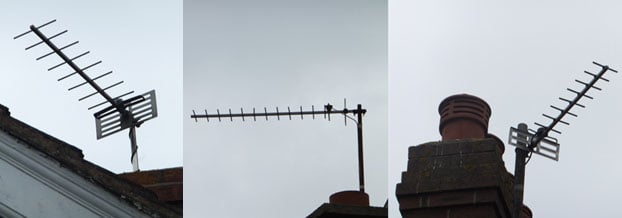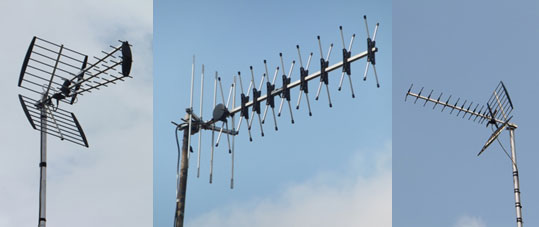The humble TV aerial has been a fixture of UK skylines for around 80 years.
Despite the growth in satellite and cable, millions of homes still rely on their rooftop aerials for all their TV viewing, and more many for their second sets.
But did you know that if your aerial is more than ten years old it may need to be replaced
Corrosion from the elements can affect its performance over time. This is particularly true in coastal areas where the lifespan of an aerial may actually be less than ten years.
If your TV reception is unreliable and you think you need to replace your aerial, we would advise most consumers to buy a wideband aerial.
There are two categories of aerial - grouped aerials and wideband aerials.
 Grouped aerials
Grouped aerials
Grouped aerials are designed to receive a specific frequency band or group of channels.
You may be able to tell whether you have a grouped aerial if the elements or fins along the length of the aerial are the same size and equally spaced.
 Wideband aerials
Wideband aerials
Wideband aerials can receive a wider range of signals than grouped aerials.
Unlike grouped aerials, wideband aerials have elements of different lengths and spacing.
Modern wideband aerials are sometimes known as Type T (for 'total'), or slightly older designs as Type W (for 'wideband').
Because wideband (T or W) aerials cover the entire range of signals used to transmit digital TV. They are more future-proof and will continue to work even if there are changes to your TV signals (see box).
With more people using the internet on the move, demand for mobile data is predicted to grow massively over the next decade.
To cope with this, Ofcom is making part of the frequency band currently used to transmit Freeview available for mobile broadband. This will happen from 2022, or possibly up to two years earlier.
For most Freeview viewers, the change will only involve a simple retuning of their TV or set-top box.
However, a very small minority of households may need to replace their rooftop aerial with a wideband aerial.
Using a wideband aerial may also have other benefits.
For example, in some areas a wideband aerial will enable you to receive additional Freeview HD channels (provided you have a Freeview HD TV, digital recorder or set top box) which you wouldn't be able to receive with a grouped aerial. Type T aerials are also designed to reject signals from mobile phone transmitters, and should be better at avoiding interference than Type W aerials or some grouped aerials.
Replacing your aerial
If you need to replace your rooftop aerial, you should contact a competent aerial installer.
They will be able to advise you on the best aerial for you, depending on your location.
You should make sure you use an aerial installer who is accredited by a trusted industry body, like the Confederation of Aerial Industries (CAI) or the Registered Digital Institute (RDI).
You can search for an accredited aerial installer on the CAI's database or the RDI's database.
